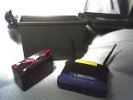|
Written by Rick Kirchhof, NG5V
|
|
Saturday, 27 February 2010 23:54 |
|
When ideas first started being discussed for a higher-speed data transport system, nearly everything was based on ARES and ARCHES. As we talked it over, it became clear that a good idea could be used in more places than just Austin/Travis County, so ARCHES (as a Travis County project) didn't really apply. The original name was chosen to be ARES-MESH. We ran with this for quite a while and got some chances to show it off to other area ham groups under the original name. Glenn Currie, KD5MFW was/IS a tireless spokesman and is constantly promoting the project. Glenn was one of the original developers and presented HSMM at Austin Summerfest, The Austin Amateur Radio Club, Travis County ARES as well as other nearby clubs.
As the firmware became more mature it became much easier to use. David, AD5OO solved some of the early user training needs by deploying a self-configuring IP address process. It was obvious that our original thoughts about broader use were right on target. With each event where HSMM was presented, it became more clear that our small team, meeting in Austin, could not fully support people using hands-on methods.
One or two of the RoadRunners Microwave Group (RMG) became very skilled in short order and helped with other RMG members that were out of town. Still... It was obvious that a Web Page would be needed to try and avoid massive amounts of email and phone work for anyone in Austin to support hams elsewhere. To this, add a broad exposure event when K8OCL, Dr. John Champa (now a SK) wrote the CQ-VHF article on recent HSMM development work and featured our project. John goes waaaay back on this one to the original ARRL HSMM developmental working group of several years ago. This was also called the Hinternet. The name HSMM as used by the ARRL means High Speed Multi Media.
Several mail lists, tons of discussion and quite a bit of development work happened before internal disputes between developers and misunderstandings inside the ARRL caused the ARRL board to disband the working group. To separate the two efforts, both groups were directly interested in HSMM to supplement the 1200 baud packet data network in use. MESH was known and tested only in Austin and much later than the (now) dissolved ARRL work group. John had been contacted by NG5V, KD5MFW and possibly others on our team by mail during the life of their working group. After it's demise, we kept in touch because HSMM development didn't stop just because the ARRL unplugged things at their end. John is an active member of our current group. He is a great resource because of his experience and extensive list of contacts in industry and the ARRL.
While reviewing the CQ-VHF drafts, the question of project name validity arose. Along with this discussion was the need to protect our work against theft and commercialization by another group or company. We decided to research some of the rules about ARES and our then-current project name. As a result, we discovered that ARES is a registered trademark of the ARRL. Since we wanted to get a web presence, we could not include a trademarked name within the URL. We wanted our own trademark for the same reason. John's article mentions our trademark and the core developers.
Although HAM-MESH and several other names were examined, it seemed more accurately described by the HSMM topic and the word MESH. This created a new project name of HSMM-MESH™. Versions of the firmware beginning with 0.3.1 change the SSID and IDs sent inside the network traffic to the new name. We have pulled domains for HSMM-MESH in .com, .org, and .net to ensure that we can use always have the web page be controlled by us. The web page exists and is now online as hsmm-mesh.org We expect it to both open the door further (exposure-wise) and to greet new hams with a dose of helpful information to get their own MESH nodes into use.
|
|
Last Updated on Tuesday, 17 April 2012 01:44 |



